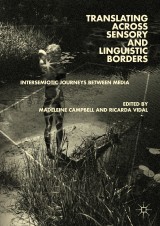Details

Translating across Sensory and Linguistic Borders
Intersemiotic Journeys between Media|
160,49 € |
|
| Verlag: | Palgrave Macmillan |
| Format: | |
| Veröffentl.: | 08.12.2018 |
| ISBN/EAN: | 9783319972442 |
| Sprache: | englisch |
Dieses eBook enthält ein Wasserzeichen.
Beschreibungen
This book analyses intersemiotic translation, where the translator works across sign systems and cultural boundaries. Challenging Roman Jakobson’s seminal definitions, it examines how a poem may be expressed as dance, a short story as an olfactory experience, or a film as a painting. This emergent process opens up a myriad of synaesthetic possibilities for both translator and target audience to experience form and sense beyond the limitations of words. The editors draw together theoretical and creative contributions from translators, artists, performers, academics and curators who have explored intersemiotic translation in their practice. The contributions offer a practitioner’s perspective on this rapidly evolving, interdisciplinary field which spans semiotics, cognitive poetics, psychoanalysis and transformative learning theory. The book underlines the intermedial and multimodal nature of perception and expression, where semiotic boundaries are considered fluid and heuristic rather than ontological. It will be of particular interest to practitioners, scholars and students of modern foreign languages, linguistics, literary and cultural studies, interdisciplinary humanities, visual arts, theatre and the performing arts. <p></p><div><br></div><div><br></div><div><br></div>
<div>Chapter 1: Entangled Journeys: An Introduction; Madeleine Campbell and Ricarda Vidal.- Chapter 2: The Translator’s Gaze; Madeleine Campbell and Ricarda Vidal.- Chapter 3: Incarnating a Poem in Images: an Intersemiotic Translation of “Tramonto” by Giuseppe Ungaretti; Eugenia Loffredo.- Chapter 4: The Case of the Poem In Motion: Translation, Movement and The Poetic Landscape; Manuela Perteghella.- Chapter 5: Synaesthesia and Intersemiosis: Competing Principles in Literary Translation; Clive Scott.- Chapter 6: Pierre de Ronsard’s "Ode A Cassandre": Recall, Erasure and Recolouration; Vahni Capildeo.- Chapter 7: Translating Titles and Content: Artistic Image and Theatrical Action; John London.- Chapter 8: Hysteria, Impropriety and Presence: Towards a Feminist Approach to Intersemiotic Translation; Cara Berger.- Chapter 9: Hosting Hysteria; Laura González.- Chapter 10: Affordance as Boundary in Intersemiotic Translation: Some Insights from Working with Sign Languages in Poetic Form; Kyra Pollitt.- Chapter 11: Beyond Representation: Translation Zone(s) and Intersemiotic Translation; Heather Connelly.- Chapter 12: Translation is Dialogue: Language in Transit; Arlene Tucker.- Chapter 13: An Analytic of Making: Translating Berman’s Twelve Deforming Tendencies; Bryan Eccleshall.- Chapter 14: Movement as Translation: Dancers in Dialogue; Ella McCartney.- Chapter 15: Transitional/Translational Spaces: Evocative Objects as Triggers for Self-Negotiation; Gaia Del Negro.- Chapter 16: Disorienting Dilemmas in Immersive Dance: Caroline Bowditch’s “Frida” and Stephanie Springer’s “Bittersuite”; Marta Masiero.- Chapter 17: Life’s Too Short: On Translating Christian Marclay’s Photo-Book The Clock; Jen Calleja.- Chapter 18: Radical Ekphrasis; or, An Ethics of Seeing; Sophie Collins.- Chapter 19: Adventures in Intersemiotic and Metaphysical Translation; Robert Prosser and Steven J Fowler.- Chapter 20: Refractions: In Lieu of a Conclusion; Madeleine Campbell and Ricarda Vidal.</div><div><br></div>
<div><div><b>Madeleine Campbell </b>is an associate tutor at the University of Edinburgh, UK, and a freelance writer, researcher and translator. She researches intersemiotic translation as practice, and she is also Secretary of Cultural Literacy in Europe, leading its special interest group on Intersemiotic Translation. Her collaborative <i>Jetties </i>project staged Algerian Mohammed Dib's writings and her translations of Occitan Aurélia Lassaque appeared at Poetry International Rotterdam (2018).</div><div><b><br></b></div><div><b>Ricarda Vidal</b> is a teaching fellow, translator and curator based at King’s College London, UK. As curator of <i>Translation Games </i>and <i>Talking Transformations</i>, she explores intersemiotic translation as practice-based research and for public engagement. Her recent books include <i>Death & Desire in Car Crash Culture</i> (2013), <i>The Power of Death </i>(2014), <i>Alternative Worlds</i> (2014), and <i>Revolve:R bookworks</i> (2012-18). </div><div><br></div></div>
This book analyses intersemiotic translation, where the translator works across sign systems and cultural boundaries. Challenging Roman Jakobson’s seminal definitions, it examines how a poem may be expressed as dance, a short story as an olfactory experience, or a film as a painting. This emergent process opens up a myriad of synaesthetic possibilities for both translator and target audience to experience form and sense beyond the limitations of words. The editors draw together theoretical and creative contributions from translators, artists, performers, academics and curators who have explored intersemiotic translation in their practice. The contributions offer a practitioner’s perspective on this rapidly evolving, interdisciplinary field which spans semiotics, cognitive poetics, psychoanalysis and transformative learning theory. The book underlines the intermedial and multimodal nature of perception and expression, where semiotic boundaries are considered fluid and heuristic rather than ontological. It will be of particular interest to practitioners, scholars and students of modern foreign languages, linguistics, literary and cultural studies, interdisciplinary humanities, visual arts, theatre and the performing arts. <div><br></div><div><br></div><div><div><b>Madeleine Campbell</b> is an associate tutor at the University of Edinburgh, UK, and a freelance writer, researcher and translator. She researches intersemiotic translation as practice, and she is also Secretary of Cultural Literacy in Europe, leading its special interest group on Intersemiotic Translation.</div><div><br></div><div><b>Ricarda Vidal</b> is a teaching fellow, translator and curator based at King’s College London, UK. As curator of <i>Translation Games</i> and <i>Talking Transformations</i>, she explores intersemiotic translation as practice-based research and for public engagement.</div></div><div><br></div>
<p>Provides one of the first full-length and fully interdisciplinary works on intersemiotic translation</p><p>Includes examples of intersemiotic translation in action, drawing on fields as diverse as semiotics, cognitive poetics, psychoanalysis and transformative learning theory</p><p>Brings together contributions from academics, translators, curators, performers and artists</p><p>Includes original poetry and artwork</p>
Diese Produkte könnten Sie auch interessieren:

Die Grundzüge von Austins Spechakttheorie. Eine Analyse von "How to do things with Words"

von: Mirko Krämer

13,99 €
















